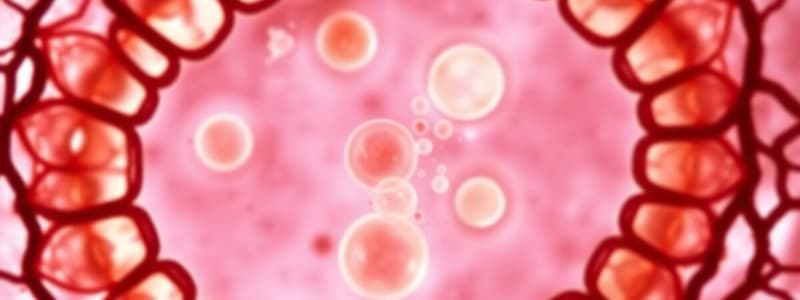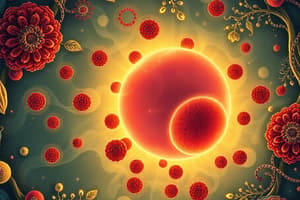Podcast
Questions and Answers
What is the primary function of the cell membrane?
What is the primary function of the cell membrane?
- To regulate transport of substances (correct)
- To synthesize proteins
- To provide structural support
- To store genetic information
Which type of organelle is mitochondria classified as?
Which type of organelle is mitochondria classified as?
- Non-membranous organelle
- Temporary inclusion
- Membranous organelle (correct)
- Permanent inclusion
What characteristic helps distinguish the cell membrane at high magnification under electron microscopy?
What characteristic helps distinguish the cell membrane at high magnification under electron microscopy?
- It has two electron-dense lines (correct)
- It shows no visible structure
- It has a single dense line
- It appears as a solid mass
What are ribosomes primarily responsible for?
What are ribosomes primarily responsible for?
Which characteristic is true about organelles?
Which characteristic is true about organelles?
What is the function of the Golgi apparatus?
What is the function of the Golgi apparatus?
Which of the following is not a type of non-membranous organelle?
Which of the following is not a type of non-membranous organelle?
What microscopic technique is used to observe ultrastructural features of the plasma membrane?
What microscopic technique is used to observe ultrastructural features of the plasma membrane?
What is the primary function of mitochondria in a cell?
What is the primary function of mitochondria in a cell?
Which structure of the mitochondria increases its surface area for ATP production?
Which structure of the mitochondria increases its surface area for ATP production?
In which type of cells would you expect to find a high number of mitochondria?
In which type of cells would you expect to find a high number of mitochondria?
What is the primary function of cholesterol in the cell membrane?
What is the primary function of cholesterol in the cell membrane?
What type of genetic inheritance pattern is commonly seen with diseases linked to mitochondrial DNA?
What type of genetic inheritance pattern is commonly seen with diseases linked to mitochondrial DNA?
Which of the following symptoms might indicate a mitochondrial disorder?
Which of the following symptoms might indicate a mitochondrial disorder?
Which of the following correctly describes the structure of the cell membrane?
Which of the following correctly describes the structure of the cell membrane?
What is the role of porin proteins located in the outer mitochondrial membrane?
What is the role of porin proteins located in the outer mitochondrial membrane?
What is the role of glycoproteins in the cell membrane?
What is the role of glycoproteins in the cell membrane?
What happens to the mitochondrial function in the presence of abnormal mitochondrial DNA?
What happens to the mitochondrial function in the presence of abnormal mitochondrial DNA?
Which of the following is classified as a form of bulk transport?
Which of the following is classified as a form of bulk transport?
Which type of proteins extend across the lipid bilayer of the cell membrane?
Which type of proteins extend across the lipid bilayer of the cell membrane?
What components are found in the mitochondrial matrix?
What components are found in the mitochondrial matrix?
What is the main purpose of the glycocalyx?
What is the main purpose of the glycocalyx?
In receptor-mediated endocytosis, what is primarily needed for the process to occur?
In receptor-mediated endocytosis, what is primarily needed for the process to occur?
Which statement best describes phagocytosis?
Which statement best describes phagocytosis?
What are common characteristics of MELAS?
What are common characteristics of MELAS?
Which of the following are functions of the Golgi apparatus?
Which of the following are functions of the Golgi apparatus?
What distinguishes MERRF from MELAS?
What distinguishes MERRF from MELAS?
What are transfer vesicles most commonly associated with?
What are transfer vesicles most commonly associated with?
How does the Golgi apparatus contribute to protein modification?
How does the Golgi apparatus contribute to protein modification?
Which type of vesicle is formed from condensing vacuoles?
Which type of vesicle is formed from condensing vacuoles?
What symptom might not be present in a patient with MERRF?
What symptom might not be present in a patient with MERRF?
What is indicated by the negative Golgi image in H&E staining?
What is indicated by the negative Golgi image in H&E staining?
Flashcards are hidden until you start studying
Study Notes
Intended Learning Outcomes (ILOs)
- Understand microscopic features of eukaryotic cells.
- Describe electron microscopic features of plasma membrane.
- Identify and categorize membranous and non-membranous cytoplasmic organelles.
- Discuss light microscopy (LM) and electron microscopy (EM) along with functions of cell membrane, mitochondria, and Golgi body.
Cytology Overview
- Cytology is the study of cells, foundational units of all living tissues.
- Cells vary in shape (flat, cubical, columnar, rounded, irregular) and size (e.g., lymphocytes as smallest, fat cells and ova as largest).
- Cells consist of cytoplasm and nucleus, including organelles (living and permanent) and inclusions (nonliving and temporary).
Cytoplasmic Organelles
- Membranous Organelles: Includes cell membrane, mitochondria, rough and smooth endoplasmic reticulum, Golgi apparatus, lysosomes, peroxisomes.
- Non-membranous Organelles: Includes free ribosomes, polysomes, microtubules, filaments, centrioles, cilia, and flagella.
Cell (Plasma) Membrane
- Binds each cell, invisible by LM, appears as a trilaminar structure in EM (7.5 - 10 nm thick).
- Composed of lipids (30%), proteins (60%), and carbohydrates (10%).
- Lipids: Includes phospholipid bilayer and cholesterol, which fill gaps in fatty acid chains.
- Proteins: Intrinsic proteins span the bilayer; extrinsic proteins adhere to the surface.
- Carbohydrates: Form glycocalyx on the external surface, aiding in cell recognition and protection.
Functions of the Cell Membrane
- Maintains cell integrity, regulates interactions, recognizes antigens, facilitates transport (including phagocytosis, pinocytosis, and exocytosis).
- Transport Mechanisms:
- Passive Transport: Simple and facilitated diffusion.
- Active Transport: Na+/K+ pump.
- Bulk Transport: Endocytosis (phagocytosis, pinocytosis) and exocytosis.
Mitochondria
- Vary in number and size, can divide independently due to their own DNA.
- Enclosed by two membranes with distinct functions:
- Outer membrane contains transport proteins (porin).
- Inner membrane has cristae for ATP production, housing respiratory chain enzymes.
- Functions include energy (ATP) production; found abundantly in metabolically active cells (e.g., liver).
Medical Applications of Mitochondria
- Abnormal mitochondrial DNA can lead to oxidative metabolism failures.
- Common conditions include mitochondrial myopathy, central nervous system degeneration, and metabolic disturbances.
- Maternal inheritance pattern; symptoms can emerge from childhood to adulthood.
Subtypes of Mitochondrial Myopathies
- MELAS: Mitochondrial encephalomyopathy, lactic acidosis, and recurrent stroke-like episodes, with muscle weakness and seizures.
- MERRF: Myoclonic epilepsy with ragged red fibers, associated with generalized seizures.
Golgi Body
- Located between the nucleus and cell periphery, acts as the secretory apparatus.
- Appears as negative Golgi images in H&E staining; identifiable with silver stains.
- Composed of flattened, parallel vesicles; includes transfer vesicles that carry proteins from rough endoplasmic reticulum, and macrovesicles that mature into secretory vesicles or lysosomes.
Functions of Golgi Apparatus
- Packages and stores proteins, adds carbohydrates or phosphates to proteins for modification.
- Forms secretory proteins and lysosomes, renews plasma membranes.
Case Scenario
- A 32-year-old woman presenting with recurrent generalized seizures, diffuse muscular weakness, and transient left-sided paresis may indicate an underlying mitochondrial disorder, highlighting the clinical relevance of mitochondrial function.
Studying That Suits You
Use AI to generate personalized quizzes and flashcards to suit your learning preferences.




